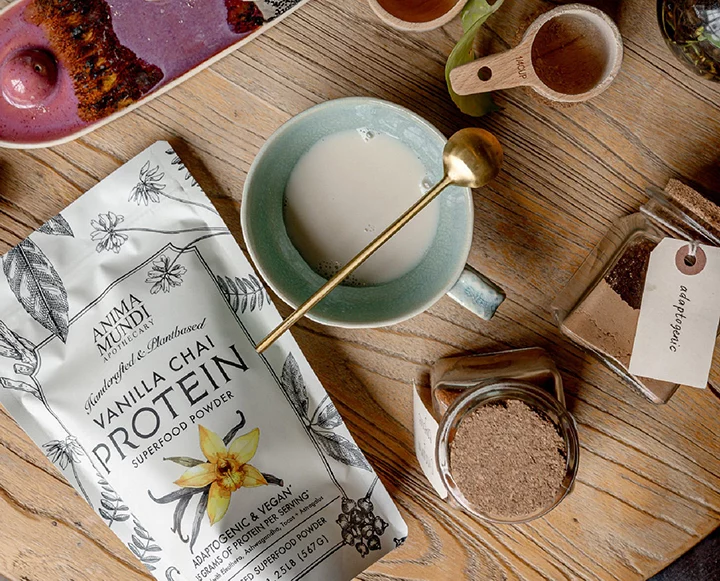Phoebe Lapine is a Hashimoto’s advocate, gluten-free chef and author of SIBO Made Simple: 90 Healing Recipes and Practical Strategies to Rebalance Your Gut for Good. As we’ve done time and again, we asked Lapine to join our The First 5 Steps series to address what she wished she’d known upon diagnosis with SIBO. Her book is a thorough guide, but we love her responses here…
A few years ago, I thought I knew everything there was to know about gut health. I had just published a book about overcoming my autoimmune disease, Hashimoto’s Thyroiditis, applying the wisdom I’d attained from top gut health pro and functional medicine minds around the world.
I was eating all the fermented veggies, crushing chickpeas and other fibrous legumes, and guzzling kombucha. And yet, over time I was beginning to feel off after every meal. Have you been there?
My Digestion Is Off: What’s the Mystery?
Having been through half a decade of digestive woes, at first I didn’t pay much attention to the bloating and constipation. I didn’t even worry that my habitual burping, and more than occasional tooting, was becoming a regular companion soundtrack to my nighttime Netflix binges.
Once I started to put the physical pieces together—the outward bloating with the inward distress—I decided to see a doctor for a full workup. The diagnosis I received was SIBO: small intestine bacterial overgrowth.
I quickly fell down the internet rabbit hole, and what I discovered about SIBO changed my entire understanding of gut health.
Researchers have estimated that over 60 percent of IBS cases are actually being caused by SIBO. The issue is not necessarily the ratio between good, beneficial bacteria and bad, pathogenic bacteria (though that could be part of it too) rather, the location of the bacteria.
Though bacteria colonize all sections of our alimentary canal, the majority of it is found in the large intestine (also known as the colon). There, it assists in the final step of our digestive labyrinth and prepares waste matter for evacuation.
The small intestine, on the other hand, is where your food intermingles with digestive juices, nutrients are absorbed into the bloodstream, and your body reaps the rewards of what you’ve just put in it.
The small intestine is not a place where bacteria have much of a function. In fact, as is the case with SIBO, their presence can cause a lot of harm.
There’s no one approach to treating SIBO, which is what often makes patients so confused.
I should know, since I was one of them. The roadmap is far from linear and streamlined. Rather, it involves many forks, detours, and steep uphill climbs that often lead you to exactly where you started.
That said, as has been my experience, the right toolkit and approach can help you avoid a lot of needless supplements, wasted time — and misery.
THE FIRST 5 STEPS: HOW TO DEAL WITH SIBO
Understand the organisms you’re targeting. The main test for SIBO is a hydrogen-methane breath test. After drinking a synthetic sugar solution (bacterial fast food), you breathe into a series of tubes at various timed intervals. The lab then measures any rises in hydrogen or methane gas in your breath. The timing is what indicates whether they are in your small or large intestine, i.e. whether their presence is normal or an indication of SIBO.
Though there are some pro’s and con’s to getting tested—a debate I hash out in my book, SIBO Made Simple—the biggest benefit is that you know exactly what type of bacteria you’re dealing with, which can then lead you to the most effective treatment option.
Find your root cause. SIBO gets a bad rap for being a notoriously difficult, chronic condition. But often the main reason it returns is because you haven’t dealt with the physical defects, lifestyle issues, or nutrient deficiencies that caused your SIBO in the first place.
This type of overgrowth is not a disease in and of itself, it’s a sign that something has gone wrong in the body—often several things!
It might be that your small intestine’s street sweeper wave—called the Migrating Motor Complex—has malfunctioned. It might be that there’s a structural issue—a cyst, growth or tumor bearing down on your intestines. Or it could be that you’re missing a safeguard that neutralizes unwanted bacteria coming in through your nose and mouth every day—low stomach acid, a missing gallbladder, or weakened immune system. It’s important to go through a thorough checklist (like the one in SIBO Made Simple) and uncover what might be causing your digestive system to go off the rails.
Rehab HOW you’re eating, not just what you’re eating. Many people who first learn they have SIBO go immediately to a low FODMAP or similarly restrictive diet. These therapeutic approaches can be helpful for limiting symptoms. But they are not a treatment in and of themselves. More importantly, food choices likely did not cause your SIBO, so focusing solely on them will not necessarily improve your recovery odds.
How you eat, on the other hand, could have a lot to do with your digestive issues. Forgetting to chew your food, drop into parasympathetic mode before a meal, get your stomach acid churning—or simply eating too close to bedtime and snacking all day long. If you’re making these foundational mistakes, your digestive system is not going to be running on all cylinders, no matter what’s on your plate.
Your migrating motor complex only kicks in during a fasting state of 90 minutes or more, so simply leaving ample time between meals (instead of grazing all day long) can have a huge impact on SIBO recovery and prevention.
Heal leaky gut and food sensitivities. Bacteria are living organisms with their own cravings (creepy, I know). High numbers of bacteria in your small intestine basically means that there are other mouths at the table competing for your dinner.
If there’s not enough nourishment to be had, bacteria will turn to the next best thing: your intestinal lining. The result is an increased permeability, also known as leaky gut syndrome, where larger food particles (instead of just essential nutrients) seep into the bloodstream.
The downwind effect is often systemic inflammation, food sensitivities and autoimmunity. Though you can have leaky gut, food intolerances, and an autoimmune disease without SIBO, it is not unusual for these conditions to be a packaged deal.
While treating SIBO usually involves some sort of “kill phase”—an antibiotic or herbal antimicrobial to eradicate the overgrowth—healing the aftermath of SIBO means getting your inflammation under control and adding lots of ‘ammo’ for healing. In my book, we talk about the ingredients that add the most insult, and those that can be thought of as heroes for healing the gut lining, like fresh ginger, turmeric, cabbage juice, and bone broth.
Focus on stress management, particularly around food fear. One of the most common, but often overlooked, root causes of SIBO is simply…stress!
Stress not only reduces stomach acid, it also impairs small intestinal motility, meaning that migrating motor complex, responsible to cleaning up after a meal, will not be functioning as well. Of course, dealing with a chronic condition like SIBO can also cause more stress! That’s where certain alternative modalities can be so helpful to explore for healing. Hypnotherapy, bodywork, acupuncture, CBT or just regular talk therapy can have a positive halo effect on both SIBO and IBS (trust me, the data is compelling!).
This becomes even more important when food is in the picture. Since symptoms are often directly related to what you’re eating, it’s really easy to develop a fraught relationship with mealtime.
Food is one of the few things we can control as a patient. And many of us have been through years of symptoms that were so ‘out of our control’ that we can become fixated on food — turning it into something that needs to be constantly questioned, instead of savored.
Remember that you cannot heal without nourishment and that food is not the enemy. Whenever possible, use positive affirmations so that when you sit down to a meal, you do so from a place of peace, not stress.













